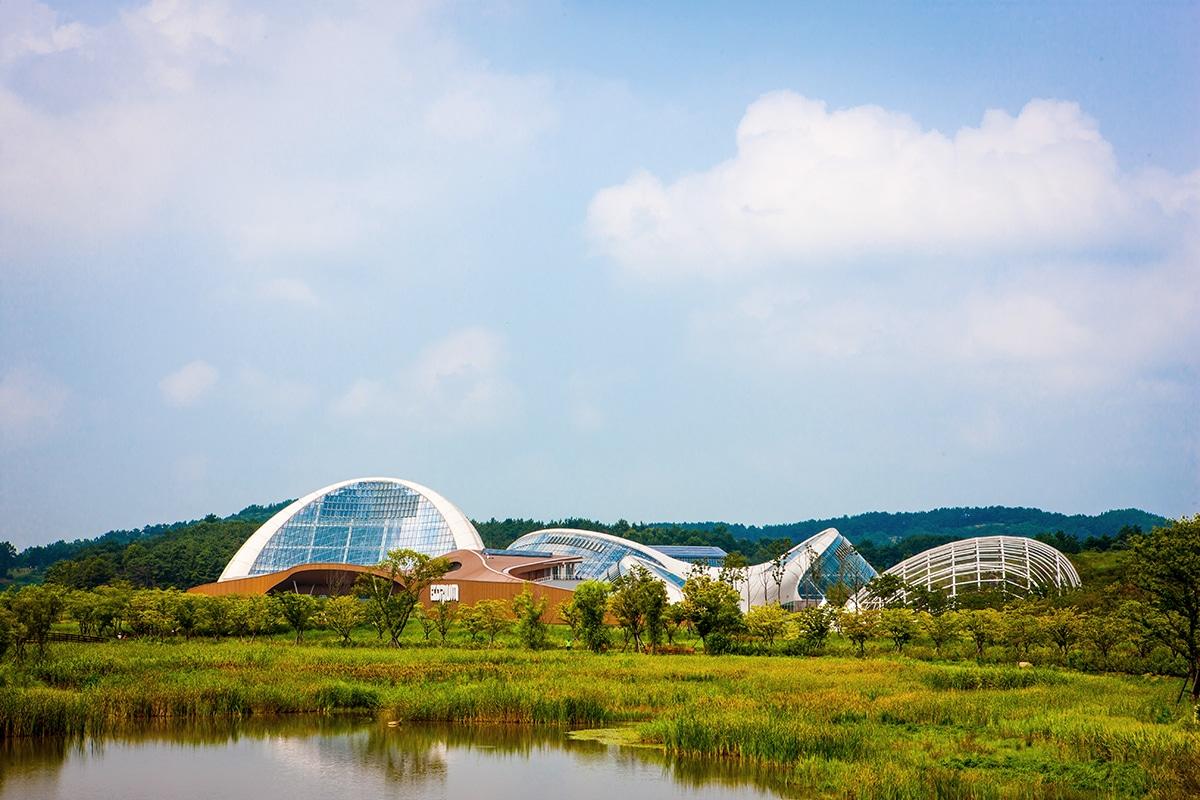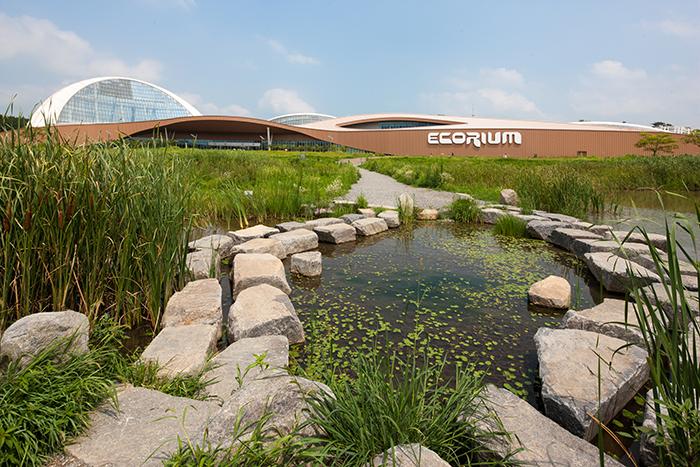Greenhouse containing blossoms of nature
Seoul Botanic Park
Chan-joong Kim | Republic of Korea

The Seoul Botanic Park was created by the Seoul metropolitan government with the aim to share educational and cultural values of nature, and offer a space for rest and leisure. In particular, the park’s greenhouse exhibits plants that are typically found in cities around the globe, including Athens, San Paolo, Barcelona, San Francisco, and Cape Town.

Unlike conventional domed greenhouses, this greenhouse boasts a unique architectural style with a plate-shaped roof. The overall structure resembles a spaceship when seen from the side, and a fully bloomed flower when seen from above. Chan-joong Kim wanted to break the stereotypical greenhouse design while adding a sense of “putting something” to the design. As a result, he turned the typical shape of a greenhouse upside down and designed a concave dish-like roof, where nature, culture, and plants can be “put” together.
The issue with creating a concave roof for a greenhouse is that the center and the edges do not receive enough sunlight as compared to domed greenhouses. To overcome such weakness, Kim used ethylene tetrafluoroethylene (ETFE) for the roof, which has a 20% higher visible light transmission rate versus ordinary glass. ETFE is a novel fluorine-based plastic material that has been used to create greenhouses for the Eden Project in the UK as well as for the National Aquatics Center in China. This new material is much lighter than glass, enabling this unique concave roof with thin frames to allow for sufficient sunlight. One good thing about having a plate-like top is that it can collect rainwater.

The park stores the collected rainwater, purifies it, and then uses it to water the plants throughout the park. Seoul Botanic Park also houses the Forest Field, the Lake Garden, the Wetland and other outdoor facilities where visitors can experience and enjoy nature.

TIP
Visitors can also go to the lake side road and the boardwalk at the Lake Garden. The lake side road is the ideal viewpoint to enjoy views of the botanical park, and you can observe wetland plants and wild animals from the boardwalk.
TOURIST ATTRACTIONS
Hangang Park
Address
161 Magokdong-ro, Gangseo-gu, Seoul
Way
5-min walk from Exit 3 of Magongnaru Station, Subway Line 9 or AREX
Tel
033-730-9000
Admission
Greenhouse & Themed Gardens: 5,000won / Forest Field, Lake Garden, and Wetland: Free
Website
botanicpark.seoul.go.kr
Time
Mar–Oct 9:30–18:00; Nov–Feb 9:30–17:00 (Closed Mondays)
Space portraying the life and energy of nature
Ecorium
Samoo Architects & Engineers | Republic of Korea

Ecorium is a landmark of the National Institute of Ecology, Asia’s largest ecological research institute. As a space where you can experience and “communicate” with nature, Ecorium exhibits approximately 1,400 plant species and 260 animal species that were selected from field visits and documentary surveys. Ecologies of various different climate zones (i.e. Tropical, Desert, Mediterranean, Temperate and Polar) have been recreated as similar as possible to the actual climates so that visitors can easily understand the relation between each climate and its flora and fauna.

When designing Ecorium, Samoo Architects & Engineers chose three different concepts: a symbolic artwork inspired by nature (“From Nature!”), an ecological environment that realizes nature as is (“Be Nature!”), and an ecological complex where visitors can enjoy and experience nature (“With Nature!”).

Designed under these concepts, the buildings resemble waves driven by the wind, and when seen from the path leading to the main gate, the botanical garden embodies nature’s dynamic energy. Plus, the building was designed in consideration of the sun’s movement as well as the flow of the wind to reproduce real ecological conditions inside the exhibition space. The greenhouses were carefully designed and arranged using state-of-the-art technology so that each greenhouse can secure a sufficient amount of sunlight all year round. The architects also created an optimum ecological environment through shadow movement simulations to ensure that no greenhouse casted a shadow over another. The exhibition hall also holds activity classes that teach ecological structure and functions. The passages that were meant to communicate with nature allow visitors to feel the preciousness of nature.
In order to preserve the ecosystem, the entire site was constructed with environmentally friendly systems. Natural environmental control technologies were deployed to reduce energy consumption, and the buildings use geothermal energy as the main energy source to reduce carbon dioxide emission. Likewise, Ecorium contributes to the preservation of ecosystems and prevention of global warming, and highlights the importance of environmental preservation through botanical exhibitions.


In order to preserve the ecosystem, the entire site was constructed with environmentally friendly systems. Natural environmental control technologies were deployed to reduce energy consumption, and the buildings use geothermal energy as the main energy source to reduce carbon dioxide emission. Likewise, Ecorium contributes to the preservation of ecosystems and prevention of global warming, and highlights the importance of environmental preservation through botanical exhibitions.
















![[A ZONE] Gangnam Food Spot](https://www.dgram.co.kr/wp-content/uploads/2020/09/A존-알래스카3-특성이미지_S-324x160.jpg)
![[A ZONE] Gangnam Life Style](https://www.dgram.co.kr/wp-content/uploads/2020/09/로우클래식1-특성이미지_S-324x160.jpg)




